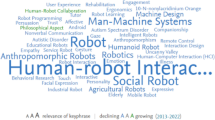Abstract
What is ‘certainty’ in our everyday life and work? AI changing what it means to ‘be certain’. For example, when we engage with others and are doing our work, we make judgments in which we ‘trust our instinct’. Are we still able to do so if we engage with the ‘certainty’ of the machine? How is ‘being certain’ in ‘dialogue’ affected by our conceptions of what it means to be human in interaction with the ‘machine’, and consequent distinctions between body and mind? Descartes first likened the human body to a machine (albeit a machine created by God) and endowed reason as being a transcendent universal instrument. La Mettrie proposed that language and culture separates humans from ‘animals’. However, in Diderot’s writing, ‘knowledge’ is seen as embodied, coming from our senses and language, and where gesture and rhythm evolve in practice. For D’Alembert, human ‘instinct’ is a skill, a learnt practice, and Rousseau believes that human certainty is something that cannot be measured. These questionings of the dichotomies of body and mind and human and animal, that relate practice and knowledge, also question the place and meaning of ‘rules’ of engaged practice. For Wittgenstein, one learns to make judgments through personal experience, ‘rules in practice’, whereby language is necessarily culturally situated and embodied, and calculation and Judgement are part of each other.
Similar content being viewed by others
Notes
Researchers are keen to believe that they possess a competence and a language that are universal and therefore also “superior” to the knowledge and the language they are researching. In one sense their language is bound to be more universal, but as a result it is more abstract and less rich. Awareness of this problem is one of the reasons to conduct case studies over long periods, in particular to develop these case studies through very close links with “the subjects of study”.
References
Cottingham J, Stoothoff R, Murdoch D (1985) The philosophical writings of descartes. Cambridge University Press, Cambridge
D’Alembert JBlR (1981a) Introduction to the Encyklopedia. Translated into Swedish by Jan Stolpe. Carmina, Uppsala
D’Alembert JBlR (1981b) Instinkt. Translated into Swedish by Jan Stolple. Dialoger, Stockholm, p 13/89
Descartes R (2006) Discourse on Method (first published in 1637). Translation with an introduction by Ian Maclean. Oxford University Press, Oxford
Diderot D (1963) Paradoxe sur le comédien (Paradox of comedy). Translated into Swedish by Teddy Brunius. Prisma, Stockholm
Diderot D (1966) Rameau’s nephew/D’Alembert’s dream. Translated by Leonard Tancock. Penguin Classics, London
Diderot D (1988) Diderot Brev till Sophie Valland (Diderot’s Letter to Sophie Valland). Translated into Swedish by Olof Nordberg. Atlantis, Stockholm
Edelman G (1992) Bright air brilliant fire. On the matter of the mind. Penguin Books, London
Florin M (1991) Skill and technology. The Centre for Working Life (SCWL), Stockholm
Göranzon B (1993) The practical intellect. Computers and skills. Springer Verlag, London
Hirn Y (1964) Det estetiska livet (The aesthetic life). Prisma, Stockholm
Ingwald A, Göranzon B (Eds) (2021) Skill and technology: within the masters programme of innovation through business, engineering and design. Linneaus University, Faculty of Technology, Report No. 52, 2019 (expanded version in 2021)
Janik A (1995) Rameau’s nephew: dialogue as gesamtkunstwerk for enlightenment. In: Göranzon Bo (ed) Skill, technology and enlightenment on practical philosophy. Springer-Verlag Ltd, London
Johannessen KS (1992) Rule following, intransitive understanding and tacit knowledge. In: Göranzon Bo, Florin M (eds) Skill and education: reflection and experience. Springer-Verlag Ltd, London
Lindborg R (1983) Maskinen, människan och doktor La Mettrie (The machine, man and doctor, La Mettrie). Doxa, Lund
Locke J (1960) An essay concerning human understanding. In: Andrew Seth Pringle-Patterson (ed) Clarendon Press, Oxford
Molander B (2015) The practice of knowing and knowing in practices. Peter Lang, Frankfurt am Main
Rousseau JJ (1982) Emile. Trans. Barbara Foxley (in 1911). JM Dent&Sons, Ltd., London
Tempte T (1991) The chair of tut anch amon. In: Göranzon B, Florin M (eds) Dialogue and technology: art and knowledge. Springer Verlag, London
Wittgenstein L (1953) Philosophical investigations. Basil Blackwell, Oxford
Wittgenstein L (1969) On certainty. Basil Blackwell, Oxford
Wittgenstein L (1975) Lectures on the foundations of mathematics, Cambridge 1939 (Edited by Cora Diamond). University of Chicago Press, Chicago
Wittgenstein L (1978) Remarks on the foundation of mathematics, 3rd edn. Basil Blackwell, Oxford
Wittgenstein L (1980) Culture and value. Blackwell, Oxford
Yates F (1975) The art of memory. Routledge & Kegan Paul, London
Author information
Authors and Affiliations
Corresponding author
Additional information
Publisher's Note
Springer Nature remains neutral with regard to jurisdictional claims in published maps and institutional affiliations.
Rights and permissions
About this article
Cite this article
Göranzon, B. On dialogue and certainty. AI & Soc 38, 1829–1836 (2023). https://doi.org/10.1007/s00146-021-01307-9
Received:
Accepted:
Published:
Issue Date:
DOI: https://doi.org/10.1007/s00146-021-01307-9



